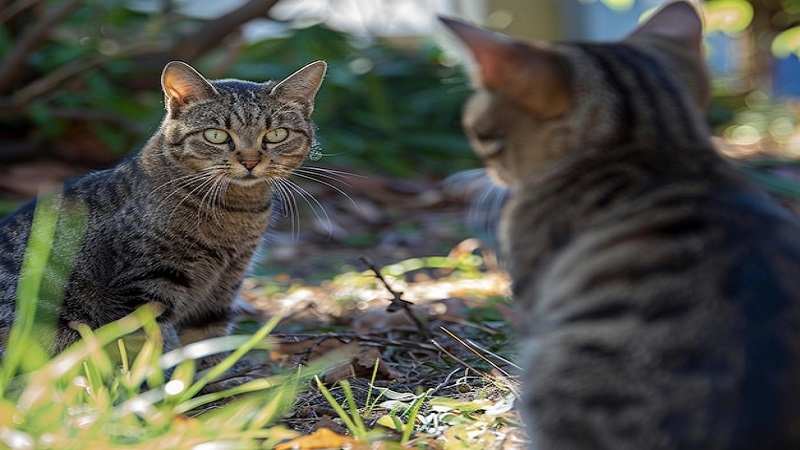Feral cat are intriguing yet often misunderstood. While they may seem like just another part of the urban landscape, they have a significant impact on both their immediate environment and broader ecosystem. This article will explore what feral cats are, their differences from stray cats, how to help them, and their importance in our world.
What is a Feral Cat?
A feral cat is a domestic cat that has reverted to a wild state. These cats typically live in colonies and are often born in the wild or abandoned by humans. Unlike stray cats, feral cats have had limited or no human contact. This lack of socialization means they are usually wary of people and avoid human interaction whenever possible. Feral cats tend to live in outdoor environments such as alleyways, parks, and abandoned buildings. They are adept at surviving in these conditions, hunting for food, and forming tight-knit colonies with other feral cats.
Feral Cat vs. Stray Cat
It’s essential to differentiate between feral cats and stray cats. Stray cats are domestic cats that have lost their way or have been abandoned but are accustomed to human contact. They are often friendly and may approach people for food or attention. Stray cats can usually be adopted into homes with some effort. In contrast, feral cats are more elusive and generally avoid human interaction. They are not accustomed to being handled or cared for by people. Understanding these differences is crucial when encountering a cat outside, as it affects how you should approach the situation.
How to Help a Feral Cat
Helping a feral cat requires a thoughtful approach. One of the most effective methods is Trap-Neuter-Return (TNR). This process involves:
- Trapping: Using humane traps to capture the feral cat.
- Neutering/Spaying: Taking the cat to a veterinarian to be neutered or spayed. This prevents further reproduction.
- Returning: Releasing the cat back to its original location, where it can continue to live in its familiar environment.
TNR is beneficial as it helps control the feral cat population and improves their overall health. Many TNR programs also provide vaccinations and medical care for the cats, addressing common health issues and preventing the spread of diseases.
In addition to TNR, providing food, water, and shelter can greatly improve the quality of life for feral cats. However, it’s crucial to approach feeding and sheltering feral cats with care. Overfeeding or attracting too many cats can lead to other issues, such as increased local rodent populations or conflicts with other animals.
The Importance of Feral Cats
Feral cats play a significant role in their ecosystems. As natural predators, they help control the population of rodents and other pests. This predation can reduce the spread of diseases carried by these pests and help maintain a balance in the environment. In some urban areas, feral cats have been credited with decreasing the number of rats and mice, contributing to cleaner and healthier surroundings.
However, the presence of feral cats can also present challenges. Overpopulation can lead to competition for resources, spread of diseases, and impact on native wildlife. This is why managing feral cat populations through TNR and other humane methods is essential. It helps ensure that feral cats continue to contribute positively to the environment while minimizing potential negative impacts.
Frequently Asked Questions About Feral Cats
What should I do if I find a feral cat?
If you encounter a feral cat, the best approach is to contact a local animal rescue organization or animal control agency. They can provide guidance on how to trap the cat humanely and offer assistance with TNR programs. It’s essential not to attempt to handle or approach the cat directly, as this can be dangerous for both you and the cat.
Can a feral cat become a pet?
While it is possible to socialize a feral cat, it is often challenging and time-consuming. Feral cats are not used to human interaction and may never fully adjust to living indoors or being around people. If you’re considering adopting a feral cat, be prepared for a significant commitment and understand that success is not guaranteed. Working with professionals experienced in feral cat socialization can increase your chances of success.
Are feral cats dangerous?
Feral cats are generally not dangerous to humans, but they can be unpredictable if they feel threatened. It’s important to approach them with caution and avoid direct contact. They may scratch or bite if they perceive a threat. If you need to interact with a feral cat, do so from a safe distance and use humane traps or other tools designed for this purpose.
How can I help reduce the feral cat population?
Supporting and participating in TNR programs is one of the most effective ways to help control the feral cat population. These programs work to reduce the number of feral cats by preventing further reproduction and improving the health of the cats. Additionally, educating others about feral cats and advocating for humane treatment can contribute to more widespread support for these initiatives.
Do feral cats need to be vaccinated?
Yes, feral cats should be vaccinated, particularly against diseases such as rabies. Many TNR programs include vaccinations as part of their services to protect the health of the cats and the community. Ensuring that feral cats are vaccinated helps prevent the spread of diseases and contributes to their overall well-being.
Conclusion
Feral cats are a unique and vital part of our environment. While they may seem like a problem at times, understanding their role and how to manage their populations can lead to positive outcomes for both the cats and the communities they inhabit. Through humane methods like TNR and community support, we can help ensure that feral cats live healthier lives while balancing their impact on the environment. If you encounter a feral cat, remember that there are ways to assist without causing harm, and your efforts can make a significant difference.
